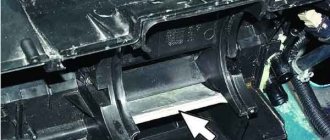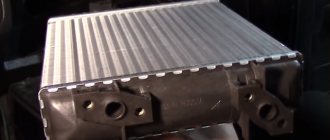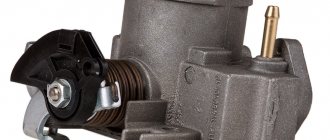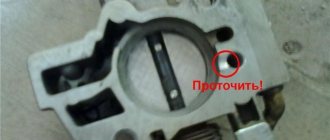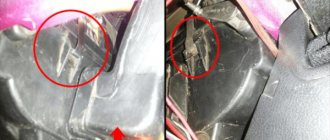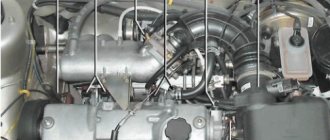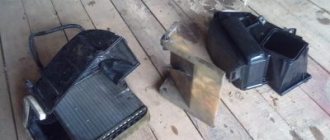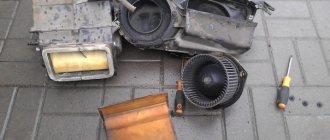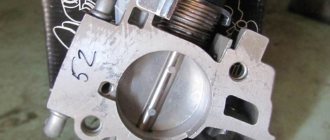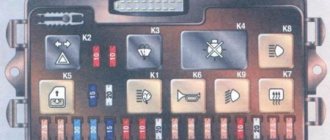In general, the problem is that the stove does not blow very warmly, the gear motor is broken (does not make sounds), I think it did not press the damper tightly, which is why the stove does not heat
IS IT POSSIBLE to somehow close the heat/cold damper manually?
2110, 2006, euro panel. I'll delete the topic myself.
Comments 25
You unscrew the wipers, unscrew the frill, on the left side of the car you put your hand to the stove and feel... I have a 2002 unit, I could barely get there to unscrew it, but it still worked... The fact is that the heater damper gear motor is not the same type, they are of different years and types, so it’s better to remove them, go to the spare parts store and ask for the same one... Mine cost 1800 rubles in the summer, and was not of the best quality (plastic), so I went through the mechanism of the old one, screwed it up well, pressed the case and put it back... It works ))) By the way, I have a topic about the stove and a hand-made homemade test controller (ala everything directly).
On the VAZ 10th family, which includes the VAZ 2110-2112 models, the designers used an electronically controlled interior heating system, thanks to which the temperature set by the driver is maintained automatically.
On the VAZ-2110, instead of a manual heater control mechanism with a cable drive of the main elements - the coolant shut-off valve and dampers, an automatic heater control system (AHC) controller with a temperature sensor and a gearmotor that regulates the position of the dampers are used.
In such a stove, the valve for shutting off the antifreeze supply is no longer used, and the adjustment of the heater operating mode - “heating” or “ventilation” - is carried out by a central damper, which directs the air flow through the radiator or bypassing it.
How malfunctions manifest themselves
The automatic temperature maintenance system used on the VAZ-2110 is more convenient in terms of control, since the automatic control system does everything independently, but is less reliable than a mechanical cable drive. Moreover, problems are caused by the electronic and electrical components of the stove - the controller, temperature sensor and micromotor gearbox, the central damper, which regulates the air supply to the cabin from the outside.
Problems with the operation of the VAZ-2110 heater related to the damper:
- lack of temperature control (only hot or cold air comes from the stove) regardless of the position of the handle on the controller;
- insufficient air heating (even when setting the handle to the maximum temperature);
- squeaks, knocks and extraneous noises after setting the temperature.
The cause of such problems is the central damper of the VAZ-2110 stove, which is adjusted by the controller through a gearbox. The design of the stove includes another damper - air distribution into zones. It is controlled using a handle mounted on the central air supply deflector into the cabin, so malfunctions with this part are rare.
Let's sum it up
Malfunction of the VAZ-2110 heater damper is a common malfunction, especially in vehicles with old-style heaters. Breakage in most cases is due to the quality of plastic dampers, which are very often subject to deformation. It is possible to repair and replace the VAZ-2110 stove valve yourself without the help of professionals. Before starting work, you need to understand that in order to carry out high-quality repairs and restore the previous functionality of the heating system, the stove will have to be completely dismantled.
Despite the complexity of the work ahead, the result will please the driver and passengers with warmth and comfort in the vehicle interior. A high-quality repair of the heater damper and its drive guarantees stable operation of the vehicle’s heating system at any time of the year.
Source
Features of the design of the VAZ - 2110 stove damper
Note that VAZ-2110 of different years of manufacture uses heaters that differ in design:
1. Old-style stove damper
Old heaters use two central dampers, one of which blocks the flow of air into the cabin from the outside, and the second one redirects the air flow to the heater radiator or bypasses it. They are interconnected by drives and opened by a micromotor gearbox.
2. New sample
In the new type of stove there is only one central damper and it is connected by a drive to the gear motor directly, and not through a lever.
3. Under the “Euro” panel
Structurally, such a stove does not differ from the new type of heater, but in it the damper for distributing the air flow into zones is controlled by another micromotor gearbox.
It is easy to visually distinguish the stoves by the location of the heater fan. In the old-style interior heater, the fan is located horizontally, while in the new model, it is positioned vertically. Their gearmotors are also different.
Checking the dampers of the VAZ 2110 heater system
The stove system has 2 dampers. The upper one regulates the intake of cold air, and the lower one regulates the intake of hot air from the heater radiator. And when the drive mechanism or the damper itself breaks down, the stove can heat weakly, not heat at all, or fry too much.
Breakdowns of the heater damper can be of different types; firstly, the damper often gets stuck or jams , and secondly, the damper drive (micromotor-reducer) fails . In some cases, the damper warps or jams due to rust , since there are two types of dampers: the old and the new type, the old ones are plastic with a foam rubber seal, and the new one is metal with a rubber seal. Therefore, if you cannot hear the damper moving, you can move it by hand by removing the deflector in the central panel. The problem with metal ones is that they often jam from rust, and plastic ones warp from exposure to hot air. So if, for example, warm air blows into the front window of a VAZ 2110, and hot air blows from the sides and into the legs, then most likely the damper has not completely blocked the air intake from the street. And when the dampers do not move at all, then you need to check the microdetector - the damper drive mechanism.
Causes of malfunctions
Depending on the design of the stove, the damper may cause a disruption in the efficient operation of the heater for the following reasons:
- deformation;
- wear of seals;
- deterioration or damage to control levers and rods;
- skew.
Deformation is a problem with old-style heaters. The first dampers of the VAZ-2110 stove were equipped with plastic elements that bent under the influence of temperature. Because of this, even when completely closed, cold air from outside leaks in and mixes with the heated air, and the efficiency of the stove decreases. Subsequently, the designers replaced the plastic flaps with aluminum ones and the problem with deformation disappeared.
To ensure tightness, the dampers have seals that reduce air leakage. Initially, foam rubber seals were used, which quickly wore out and became damaged. Later, foam rubber was replaced with rubber, but this only extended the service life of the seal; over time, the rubber ages, cracks and collapses.
On old-style stoves, rods and levers may break. On new heaters, there is another problem - wear on the edges of the square end of the gearbox, with which it is inserted into the groove made in the damper axis. As a result, the limit switch bypasses the groove, and the heater damper jams, although the gearmotor operates. The misalignment occurs due to the displacement of the damper axis in the mounting holes of the housing. Because of this, the damper warps and jams when opening.
Diagnosis of the problem
If the reason why the VAZ-2110 stove does not work is the damper, it is not difficult to identify it. To do this, disassemble the central deflector, turn on the ignition and rotate the temperature setting knob to its extreme positions. In a working stove, the central damper will not knock and will completely open and close the air supply channel.
If the heater damper does not move or stops in a position that does not completely block the air passage, it may be stuck. You can verify this by pushing the valve with your hand or a long rod. If after this the damper returns to its normal position, then this is the reason why it is jammed. Through the mounting hole of the deflector, you can assess the condition of the damper and its seals. If the damper is deformed, its bend is clearly visible.
Damper adjustment
Adjusting the Nissan Qashqai heater flaps is also a fairly simple procedure and can be done on your own:
- The bolt securing the rod to the drive is slightly loosened.
- The damper lever is installed in a position where it is completely open.
Damper position at maximum set temperature
Damper position at minimum set temperature
- The rod is pulled out of the casing, the mounting bolt is tightened.
- The damper drive handle is pulled out to the maximum, which can be determined by the fact that the damper itself has completely closed.
- If the damper does not close, the rod shell bolt is unscrewed.
- When moving the shell you need to look at the damper. If it is closed, the mounting bolt can be fully tightened. This completes the adjustment.
Repair and restoration of the stove damper
The deformed heater damper of the VAZ-2110 cannot be repaired; it only needs to be replaced. In this case, it is better to purchase a replacement metal part that is not so susceptible to temperature effects.
Whatever heater is installed on the VAZ-2110, to carry out repair work, the heater must be completely disassembled. In this case, the process of dismantling and disassembling depends on the design of the stove.
A positive aspect of the heater design on the VAZ - 2101 is its location - to get to it and the dampers you can from the engine compartment and you don’t have to remove the front panel.
Disassembling an old-style stove
For example, let's look at how to disassemble an old-style heater:
- Remove the terminal from the battery.
- We remove the windshield wipers, the seal, remove the air intake near the windshield (“jabot”) from the car, in the process you will need to disconnect the windshield washer nozzle tubes.
- We dismantle the insulation that separates the stove body from the engine compartment.
- We remove the gear motor.
- We divide the housing of the stove and air filter into two halves. To do this, unscrew the coupling bolts around the perimeter of the housings and remove the mounting brackets.
- Disconnect the fan power wires.
- Remove the outer half of the air filter and heater housing (along with the fan).
- We dismantle the inner part of the fan housing.
After this you will have access to the dampers. If you are only planning to repair or replace the heater dampers, there is no need to drain the antifreeze, since the heater radiator will remain in place and will not be removed.
Before removing the dampers, carefully inspect and remember their position and the way they are engaged. Further actions depend on the nature of the damage. Deformed damper parts cannot be repaired and only need to be replaced. As for damaged rods and levers, try to repair them or simply replace them. The damaged seal is replaced.
Design and operation of the VAZ 2110 heating system
The system includes the following components:
- Heater VAZ 2110, whose task is to heat the air. The main element of the heater is the radiator, through which coolant circulates.
- A fan that directs heated air into the cabin. It is attached to the casing using elastic pads that dampen vibration.
- Heater control system, including a fan button, handles and dampers for the heating mode control system.
The heating system works like this:
Through the grilles on the hood, air enters the air supply box located in the engine compartment near the windshield.
In the event of rain or downpour, the water is separated from the air and flows into the holes in the box. This allows you to use the stove in any weather, but until the radiator heats up, the air entering the cabin during rain will be damp.
The air flow is directed to the VAZ 2110 heater and heats up as it passes through the radiator. Heating is regulated using a tap, which regulates the amount of coolant passing through. The crane is controlled by a flexible rod attached to the control lever.
While driving, the air flow enters the engine compartment and the air independently enters the heater. When stopping or at low speed, an electric fan is used, controlled by a switch that has three positions: “off”, “full speed” and “low speed”. Reduced speed is achieved by turning on the electric motor through a resistor, which reduces the voltage on the motor winding.
After the radiator, the air enters the air ducts and exits through deflectors, which allow you to change the direction of flow. Warm air can be directed onto the windshield and side windows, under the feet of the driver and front passenger.
Control elements of the air flow from the VAZ 2110 stove:
- Fan air distribution cover that regulates air flow.
- Levers and handles that change the position of the air supply covers and dampers that regulate airflow.
Before repairing the VAZ 2110 stove, it is necessary to understand the causes of the malfunction.
How to find out the reasons for the breakdown of the VAZ 2110 heater damper and troubleshoot problems?
The most common problem is when the heater regulator does not perform its functions, that is, it does not respond to the driver’s commands. A hot or cold air flow comes from the air duct, regardless of the position of the regulator.
In this article we will look at how to change the heater damper of a VAZ 2110 , but first we will dwell on the causes of the breakdown.
If the gearbox is in good condition, and the damper does not “respond” to the driver’s manipulations, then characteristic clicks are heard when the regulator is switched. This indicates that the shaft is turning inside the structure. Repair can only be done in one way - replacing the old damper with a new one. It must be emphasized that the old dampers are made of plastic. In turn, the new design is made of metal. For a tight fit to the surface, gaskets made of rubber are used.
Blowing cold air - inspection of the heater radiator and cooling system
The radiator of the VAZ-2110 stove also does not have high heat transfer, and besides, it is quite difficult to get to it. However, it may be associated with a weak interior heating temperature:
- The heater radiator is clogged . If antifreeze does not get into it when the cooling system is in full working order, then it will not heat. Diagnosing a clogged stove is difficult, but it is possible. With the engine fully warmed up and the heater on, we feel the temperature of the radiator inlet and outlet pipes by touch. If the inlet is hot and the outlet is cold, the heater radiator is clogged. Few people clean it; the public prefers to buy a new one. The market will allow you to choose several models of aluminum radiators and one or two copper ones at our discretion.
The problem of radiator obstruction is solved either by flushing using special liquids, or by replacing the element.
It wouldn't hurt to check the cabin filter as well.
If the radiator leaks, you will have to dismantle it and replace it with a new one.
Video about replacing the VAZ-2110 heater radiator
First step: check the functionality of the device
Before ordering a new damper from an online store and performing repair work, you need to make sure that such actions are up to date. It is possible that the old-style VAZ 2110 heater damper could become loose, jammed, or jump out of its place. To check you need:
- start the car;
- set the regulator to different positions;
- manually move the flap.
The plastic damper has a huge disadvantage: when high temperatures occur, the plastic becomes deformed. As a result, the valve may jam, and only cold or hot air will enter the cabin.
Old-style dampers are installed on VAZ-2110 cars manufactured before 2003. As a result of manual movement of the valve, the functionality of the stove can be temporarily restored. But such work cannot be called a full-fledged repair, since after some time the problem in question will manifest itself again.
It is important to pay attention to in what case the valve can be controlled. The breakdown may be hidden in the micromotor-gearbox if the valve is controlled with the engine running and the regulator in the extreme position.
Also, do not exclude the control unit and microfan from the list. These elements can also cause the problem in question.
A malfunction of the control unit, fan and gear motor indicates that the stove needs to be replaced. This is the only solution to the problem. If the work is not completed in a timely manner, the motorist needs to prepare for more serious consequences and expensive repairs.
Of course, before opening the damper of the VAZ 2110 stove manually and moving it, you will need to remove the deflector. The air duct deflector is dismantled directly from the seat without the use of additional tools. The work must be done carefully so as not to break the wire contacts.
Functionality check
If you do not want to spend a lot of money on repairing and replacing the device, you need to first check whether such manipulations are required. To do this, you can try to return the displaced damper to its rightful place.
Traction
For this:
- Turn on the ignition;
- Switch the regulator to different positions;
- Manually move the flap;
- This way it can be returned to its original position.
Of course, you first have to dismantle the deflector to gain access to the damper. If this method works, the damper will be able to work again as before, which means it will respond to the regulator.
But this cannot be considered a full-fledged measure for restoring the functionality of the damper, since if the socket is already loosened, the unit will no longer be able to work normally. At first, you will apply the half-measures described above over and over again, but over time you will still have to replace the heater damper on the VAZ 2110.
Pay attention to the conditions under which the damper can be operated. If this happens only manually with the ignition on and the regulator turned to the extreme position, then the cause of the breakdown lies in the micromotor gearbox. Other suspects are the microfan with temperature sensor and the control unit.
If any of these components stops working normally or is completely out of order, then the heater damper will not work on the VAZ 2110. Only its replacement is required. Ignoring the problem will result in even greater repair costs in the future.
How to remove the stove on a VAZ-2110 car?
Carrying out repair work will require some effort and time. But the most important thing is to adhere to the sequence of actions. To do this you need to do the following:
- drain antifreeze or other coolant;
- disconnect the car. To do this, you need to remove the negative terminal from the battery;
- dismantle the windshield trim and the Shumka;
- remove the fan;
- disconnect the pipe from the stove;
- Remove the front part of the air intake. To complete the work, you will need to dismantle the dashboard. The work must be done carefully and slowly. Fastening elements are unscrewed inside the cabin. They are the ones who hold the stove;
- dismantling the spring brackets and fasteners of the front housing of the heating equipment;
- disconnecting all hoses from the radiator;
- removing the rear casing from the stove;
- dismantling the radiator of heating equipment.
Installing a new damper on a VAZ 2110
Before installation, you must ensure that the fork is securely coupled to the lever. The valve should be in the raised position. If this is not done, the device will not function. The procedure for installing the device follows the same pattern as disassembling, but in reverse order. At the final stage, coolant must be added to the system. It is recommended to ensure that there are no leaks in the system. Now you can turn on the heating equipment and check its functionality.
It is important to pay attention to the tightness of the connections. Only if the damper is carefully attached to the surface of the heating stove is the flawless functioning of the system guaranteed.
If your car has a standard valve made of plastic, it is recommended to replace it. The disadvantage of old valves is the foam seal, which does not have a long service life. Modern dampers are made of metal, and the rubber seal has fairly high performance characteristics. This design is practically not subject to temperature effects and fits tightly to the surface of the stove. The modernized seal plays an important role in this.
